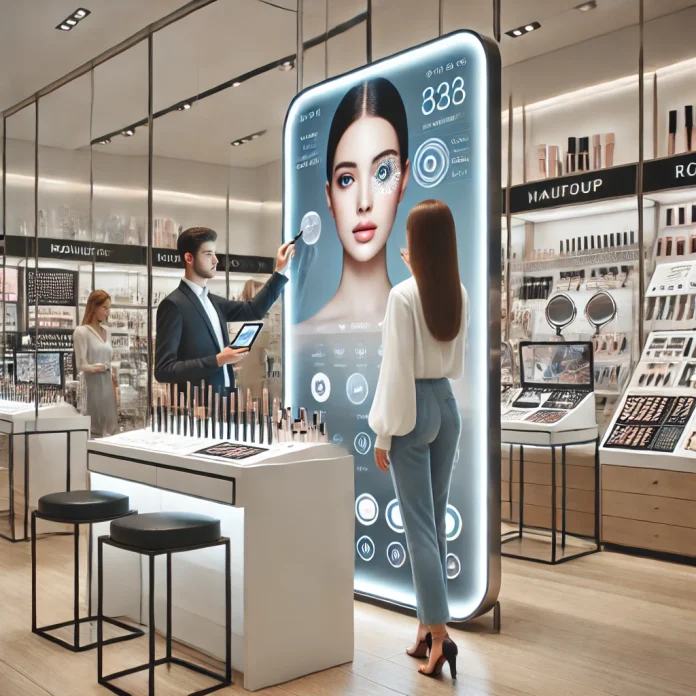The beauty industry is in the midst of a digital revolution, with technology redefining how consumers shop for makeup and skincare products in stores. From augmented reality (AR) try-ons to artificial intelligence (AI)-powered personalization, these innovations are bridging the gap between online and offline retail. Major beauty brands and retailers are investing heavily in these tools to meet the evolving expectations of tech-savvy customers. This article delves into the transformative technologies shaping the beauty retail landscape and highlights examples of their implementation.
Augmented Reality and Virtual Try-Ons: Redefining the Shopping Experience
Augmented reality has become a cornerstone of beauty retail, addressing hygiene concerns while offering a personalized experience. AR tools allow customers to virtually apply makeup, such as lipstick, eyeshadow, and foundation, without physical application.
Sephora Virtual Artist is a pioneering AR-powered tool that lets shoppers experiment with a wide range of products by simply scanning their faces using their smartphones or in-store devices. This eliminates the need for testers and enhances decision-making. (TechRepublic) Similarly, MAC Cosmetics, leveraging Perfect Corp.’s AR technology, allows customers to try on thousands of lipstick shades virtually. The realism and precision of these try-ons, which adapt to users’ facial movements, have been widely praised. (Perfect Corp.)
Walmart has also entered the AR arena by integrating a virtual makeup try-on feature into its iOS app. Partnering with Perfect Corp., this initiative empowers users to explore various beauty products digitally, enhancing the convenience of shopping from home or in-store. (Retail Dive)
Smart Mirrors: Enhancing In-Store Engagement
Smart mirrors, also known as virtual mirrors, have revolutionized the in-store experience by enabling customers to visualize products in real time. These devices display augmented overlays on a user’s reflection, showcasing how different makeup products or shades would look on their face.
In Asia, L’Oréal has installed smart mirrors in Style Nanda stores. These mirrors allow customers to see how products would appear in different lighting conditions, such as daylight or a dimly lit party environment. Similarly, Charlotte Tilbury’s Magic Mirror, located in the brand’s London flagship store, offers customers a chance to instantly try on celebrity-inspired makeup looks, increasing both engagement and purchase confidence. (Vogue Business)
AI-Powered Personalization: Tailoring Experiences to Customers
Artificial intelligence is empowering beauty retailers to offer highly personalized shopping experiences. By analyzing customer data, AI systems recommend products tailored to individual preferences and needs.
Boots’ No7 Match Made Service is an excellent example. It uses AI-powered devices to scan a customer’s skin and identify the perfect foundation shade. The tool has been a game-changer for customers seeking precise product matches. Similarly, Estée Lauder developed the iMatch Virtual Shade Expert, an AI-driven tool that scans facial features and recommends foundation shades, offering an unmatched level of precision. (Retail Dive)
Lancome’s Le Teint Particulier takes personalization a step further by creating custom-blended foundation shades in-store. This AI-powered service analyzes skin tone and delivers a unique product tailored to each customer. (Lancome)
Virtual Consultations: Bridging Online and Offline
With the rise of omnichannel retail strategies, virtual consultations have gained prominence. These tools combine the convenience of online shopping with the tactile benefits of in-store experiences.
Ulta Beauty’s Virtual Store allows customers to consult with virtual beauty advisors, explore products digitally, and even try them on using AR before visiting physical stores. This approach blends the best of both worlds, offering a hybrid shopping experience. (Publicis Sapient)
Additionally, brands like Olay have introduced AI-powered diagnostic tools that analyze skin type, hydration, and concerns, providing personalized skincare and makeup suggestions. This helps customers make informed decisions, both online and in-store. (Olay)
Omnichannel Integration: A Seamless Experience
A seamless transition between online and offline platforms is a key strategy for beauty retailers. By synchronizing digital and physical experiences, brands ensure customer convenience.
Fenty Beauty exemplifies this approach by integrating online tools with in-store experiences. Customers can explore products virtually on Fenty’s website, save their preferences, and visit stores to finalize their purchases. Similarly, Maybelline collaborates with Amazon to offer AR try-ons through Amazon’s mobile app, which customers can later experience in physical stores. (Amazon)
Challenges and Ethical Considerations
While technology is transforming the beauty industry, it raises concerns around data privacy and transparency. AI and AR tools rely heavily on personal data, making it imperative for brands to adhere to strict privacy regulations and maintain consumer trust. As technologies like facial recognition become more widespread, addressing these ethical considerations is crucial. (Forbes)
Conclusion
The integration of cutting-edge technologies like augmented reality, artificial intelligence, and smart mirrors is reshaping the beauty retail landscape. These innovations not only enhance the customer experience but also drive sales by fostering engagement and personalization. As brands like Sephora, MAC Cosmetics, and Ulta Beauty continue to push boundaries, the future of in-store makeup shopping promises to be more immersive, personalized, and convenient than ever before. By addressing ethical concerns and maintaining transparency, beauty retailers can ensure that technology remains a force for good in their industry.


